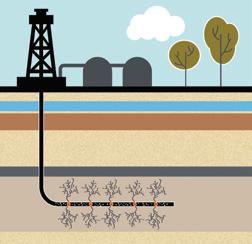INDUSTRY
Coiled Tubing Drilling Offers Rising Opportunities for Oil and Gas Recovery Worldwide By: Ikenna Idam, LWD InTouch Engineer, Schlumberger Oilfield Services USA
38
SHALE MAGAZINE MAY/JUNE 2020
control, cementing, tube logging and perforation, nitrogen kickoff, acidizing stimulation and other applications, and new uses for coiled tubing are developing daily. How it works The primary elements of a CTD operation unit consist of the four modules: 1. Reel: whether it is manufactured from a continuous carbon steel alloy sheet or special composite materials, the tubing can be over 25,000 feet long and is typically supplied on a reel spool that can weigh up to 24 tons; rolling the tubing around the reel maintains tubing flexibility during storage and transportation. 2. Control Cabin: the unit where personnel control and monitor all coiled tubing operations. 3. Injector Head: provides the force required to drive the coiled tubing string downhole and retrieve it upon completion of the operations. 4. Power Pack: generates the power required to run the coiled tubing unit as either hydraulic or pneumatic. Oil and gas operators are regularly turning to CTD to take advantage of its many operational and economic benefits. In general, coiled tubing optimizes drilling across a wider array of well conditions and is a better option for horizontal wells. Coiled tubing operations yield higher levels of producibility, performance, well control, and safety, and shorter times to mobilize. While all those factors influence the economics of drilling operations, perhaps the most significant gains come from the absence of a Workover Rig, which is not required for CTD, thereby eliminating associated rig costs. In addition, the possibility to operate within the limits of the well pressure, without the need to
kill the well, helps avoid formation damage and reduces the “trip in” and “trip out” time when compared to conventional drilling. The various applications of CTD technology are typically categorized under two broad headers: Coiled Tubing Workover and Coiled Tubing Drilling. Coiled Tubing Workover Coiled Tubing Workover (CTW) is a form of intervention activity in an existing oil well, performed when a producing well is seen to be negatively affected in productivity, and thus invariably causing a drop in revenue generated by the well. The problem may be due to an increase in the injection pressure or changes in the production characteristics, among other reasons, but the condition essentially triggers the need to improve the conditions of the well in order to bring it back to optimum production. In these cases, coiled tubing is an excellent and cost-effective solution. As there is no need to kill the well (unlike in conventional drilling), the coiled tubing is deployed in the wellbore by inserting it through the existing wellhead. This technique saves time and resources by enabling a “cleanout” activity, such as removing sand or filling from the wellbore, retrieving a failed mechanical tool, or a perforation activity. The procedure involves injecting fluid, which is applied at a fluid velocity (determined by modeling) and operating the fluid flow at an optimum velocity to avoid abrasive damage to the tubing. During this process, the fill or sand materials that have formed in the wellbore are broken up and dispersed, and the dispersed fluid is then circulated to the surface. In cases where the well has developed a high hydrostatic pressure, resulting in the inability of the reservoir fluid to flow, nitrogen is used to improve the well production. The circulation of nitrogen helps lift the borehole fluids, enabling the reservoir fluid to resume flow through the wellbore.
PHOTO COURTESY OF ICoTA
I
n 2019, the Coiled Tubing Drilling (CTD) market was valued at more than $3 billion, with well intervention services accounting for more than 60% of the market in North America and Europe. In the Middle East and Africa, oil and gas companies are investing in well intervention to increase production in mature or previously depleted oil fields, creating new opportunities for CTD expansion and resource extraction. While Russia has been slower to adopt CTD technology, its use there has risen steadily over the last decade. And in the Asia Pacific region and Latin America, growing populations combined with a government focus on reducing import dependency is hastening the demand for enhanced oil and gas recovery, driving further investment in CTD solutions to boost well production. As opportunities continue to rise worldwide, CTD is expected to grow to $4 billion by 2026, making it one of the fastest-growing segments in the oil and gas industry. Since its introduction in the mid-1960s, coiled tubing has been used for increasingly diverse applications in oil and gas exploration and drilling operations for energy and other resource by-products. The tubing is made from an alloy of carbon steel sheet or composite fiber materials, generally with diameters of 1 to 3.25 inches to fit into existing wellbores, and able to withstand downhole pressures of up to 130,000 PSI. The advent of more advanced CTD techniques in the early 1990s created new, costeffective solutions for well intervention services, enabling operators to tackle many of the challenges that affect oil and gas wells and deplete production over time, such as fluctuations in well production and injection pressure. Over the last two decades, CTD has proven to be a reliable and less expensive methodology (as compared to conventional wireline processes) for rock fracturing, production tubing, wellbore cleaning, sand










